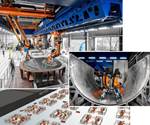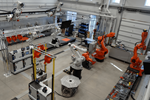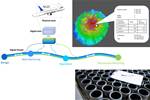Consortium partners provide CAELESTIS project update
Program targets the development of a hyperconnected simulation ecosystem supporting probabilistic design and predictive manufacturing of next-gen aircraft structures.
CAELESTIS, an EU Horizon Europe program seeking to develop next-generation, zero-carbon aircraft, kicked off in May 2022 and is due to end in 2024. To achieve this goal, consortium members have been conducting technical research into virtual prototyping and digital twins, as well as focusing on innovative materials — composites and lightweight alloys — and design techniques. The ultimate goal is to develop an end-to-end digital thread to effectively enable dataflow across the entire aircraft value chain. CW has previously reported on CAELESTIS’ key objectives; a few project partners share updates on their work below.
GKN Aerospace (Trollhättan, Sweden) has been responsible for providing component designs and aeronautical expertise. So far, the company has manufactured composite vanes via automated tape laying (ATL), and explored the one-shot process (co-bonding) which is aimed at reducing processing time and manufacturing needs; 3D printed titanium fittings will be used for the co-bonding stage. Moreover, GKN notes that it hopes to compare simulations to real manufacturing data and physical tests, which will be performed in about 12 months.
IRT Jules Verne (Bouguenais, France) is leading the CAELESTIS work package on “Digital manufacturing and defects prediction” (WP4) in addition to contributing to a project UQ&M strategy for product and manufacturing. So far, the company cites the development of a full product/process tolerancing assembly digital twin of GKN’s composite vane and for fixing the OGV’s titanium parts, based on an automatic numerical workflow between specialized software. The company provides more details here.
ESI Group (Bagneux. France) is handling the virtual prototypes side of the project. “All manufacturing processes are modeled using different length and time scales to resolve manufacturing defects,” says ESI Group. “The result uncertainty is propagated through the modeling chain. All models are managed using a digital thread providing the foundation for data traceability and interoperability.”
TU Delft (Netherlands) is handling AI and machine learning under CAELESTIS), exploring an end-to-end data-driven framework (microstructure generation, numerical simulations, machine learning algorithms) for predicting the manufacturing behavior at micro- and meso-scale and to assess the associated risk of void formation. Moreover, the project partner is studying generative algorithms for optimal positioning of fibers in dry fiber placement process to minimize geometry-induced permeability variation.
Other consortium members include AMADE – Universitat De Girona, Addcomposites, ITAINNOVA – Instituto Tecnológico de Aragón, Barcelona Supercomputing Center, eBOS Technologies Ltd. and RTDS Association.
Related Content
-
Aerotech Academy Puglia is inaugurated at Leonardo Aerospace site in Grottaglie, Italy
Joining the Leonardo MaTeRIA Lab and Joint Lab with Syensqo, this aerostructures training course will be 75% materials science and structural design/analysis, 25% digital transformation and AI.
-
How AI is improving composites operations and factory sustainability
Workforce pain points and various logistical challenges are putting operations resilience and flexibility to the test, but Industry 4.0 advancements could be the key to composites manufacturers’ transformation.
-
DLR develops safe, flexible workspaces for robot-assisted manual draping
The EU project Drapebot works on new ways of collaborating with industrial robots for manual CFRP preforming for large aircraft structural parts.
















